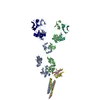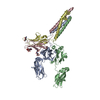+Search query
-Structure paper
| Title | Structural principles of B cell antigen receptor assembly. |
|---|---|
| Journal, issue, pages | Nature, Vol. 612, Issue 7938, Page 156-161, Year 2022 |
| Publish date | Oct 13, 2022 |
 Authors Authors | Ying Dong / Xiong Pi / Frauke Bartels-Burgahn / Deniz Saltukoglu / Zhuoyi Liang / Jianying Yang / Frederick W Alt / Michael Reth / Hao Wu /   |
| PubMed Abstract | The B cell antigen receptor (BCR) is composed of a membrane-bound class M, D, G, E or A immunoglobulin for antigen recognition and a disulfide-linked Igα (also known as CD79A) and Igβ (also known ...The B cell antigen receptor (BCR) is composed of a membrane-bound class M, D, G, E or A immunoglobulin for antigen recognition and a disulfide-linked Igα (also known as CD79A) and Igβ (also known as CD79B) heterodimer (Igα/β) that functions as the signalling entity through intracellular immunoreceptor tyrosine-based activation motifs (ITAMs). The organizing principle of the BCR remains unknown. Here we report cryo-electron microscopy structures of mouse full-length IgM BCR and its Fab-deleted form. At the ectodomain (ECD), the Igα/β heterodimer mainly uses Igα to associate with Cµ3 and Cµ4 domains of one heavy chain (µHC) while leaving the other heavy chain (µHC') unbound. The transmembrane domain (TMD) helices of µHC and µHC' interact with those of the Igα/β heterodimer to form a tight four-helix bundle. The asymmetry at the TMD prevents the recruitment of two Igα/β heterodimers. Notably, the connecting peptide between the ECD and TMD of µHC intervenes in between those of Igα and Igβ to guide TMD assembly through charge complementarity. Weaker but distinct density for the Igβ ITAM nestles next to the TMD, suggesting potential autoinhibition of ITAM phosphorylation. Interfacial analyses suggest that all BCR classes utilize a general organizational architecture. Our studies provide a structural platform for understanding B cell signalling and designing rational therapies against BCR-mediated diseases. |
 External links External links |  Nature / Nature /  PubMed:36228656 / PubMed:36228656 /  PubMed Central PubMed Central |
| Methods | EM (single particle) |
| Resolution | 4.0 - 8.2 Å |
| Structure data | EMDB-27848: IgM BCR full length EMDB-27888, PDB-8e4c:  EMDB-28030: BCRP_delta_Fab |
| Chemicals |  ChemComp-NAG: |
| Source |
|
 Keywords Keywords | IMMUNE SYSTEM / complex / membrane protein |
 Movie
Movie Controller
Controller Structure viewers
Structure viewers About Yorodumi Papers
About Yorodumi Papers








 aliivibrio fischeri (bacteria)
aliivibrio fischeri (bacteria)